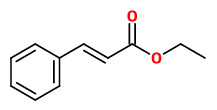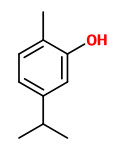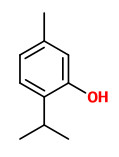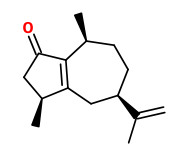Pinus cembra L. - Pinaceae - Swiss pine, Swiss stone pine, Arolla pine, Zirbelkiefer, Zirbe, Arbe, Arve
Evergreen pine tree of the European mountains (Tatra, Carpathian, Alps), up to 15m tall; bark brown; young twigs rusty-yellow, in the 2nd year with grayish-black hairs; needles stiff, 1.5mm wide; cone ovoid-shaped, up to 8cm long.
Fresh flowering cones are collected in the Alps in summer and used to flavor Schnapps (35-40% alcohol, together with some rock candy or honey) which is called „Zirbenschnaps“ or „Zirbeler“.
„The tasty and nutritious seeds contain 70% fat and 20% protein and are used today as a treat and for baking. Unlike the similar-looking pine nuts, they are usually less elongated and slightly moistier. The taste is less resinous and more reminiscent of walnuts.“ http://de.wikipedia.org/wiki/Zirbelkiefer
„The same major monoterpenes, i.e. α-pinene, β-pinene, limonene and β-phellandrene were found in both the cone and foliage volatiles of Swiss stone pine. The monoterpene profile did not vary among cones from the same tree, or among different geographic origins. A few differences were noted between trees from the same stand, and over cone development. In other conifers, cone emissions consisted of the same monoterpenes, plus 3-carene, with specific proportions related to tree species.“
[Cone and foliage volatiles emitted by Pinus cembra and some related conifer species. Dormont, L., Roques, A., & Malosse, C., Phytochemistry, Vol.49(5), 1998, 1269-1277]
Main components of the headspace of P.cembra needles were β-phellandrene (35.2%), α-pinene (29.8%), β-pinene (12.0%), and germacrene D (5.1%). Other remarkable compounds found are tetradecano-14-lactone (0.01%) and hexadecano-16-lactone (0.01%) with musky notes and (E,Z)-1,3,5-undecatriene (0.02%, intense galbanum odor).
Main components of the headspace of fresh wood shavings were α-pinene (45.0%), δ-3-carene (15.7%), limonene (5.0%), and bornyl acetate (2.6%). Lipid degradation products like (E)-hept-2-enal (0.08%), (E)-oct-2-enal (0.03%), and (E)-non-2-enal (0.08%) support the somewhat fatty and oily odor of the fresh wood.
The main compounds from the headspace of shavings from 300year old wood were α-pinene (51.9%), limonene (11.5%), α-terpineol (7.5%), and camphene (4.9%). The old wood is charaterized by a deeper, warmer scent quality. The incense-like aspect is supported by the warmth of lignin-degradation products such as creosol, 4-ethylguaiacol, p-cresol, and vanillin (present in traces).
[Scent of a vanishing flora, Roman Kaiser, 2011, 166-168 and 405-407]
α-Pinene (69.1%) was the major constituent of the essential oil (1.9%) from needles of cembran pine. Other major constituents were limonene/β-phellandrene (4.6%), camphene (2.5%), and sesquiterpenes like α-cadinene (3.7%), γ-cadinene (2.6%), bicyclogermacrene (2.4%) and cadina-1,4-diene (1.3%).
Main constituents of the essential oil of the twigs (2.4%) were limonene/β-phellandrene (40.9%), α-pinene (24.9%), β-pinene (10.3%), camphene (5.5%), myrcene (1.7%), γ-terpinene (1.5%) and δ-3-carene (1.0%). Minor constituents included α-terpinolene, nonanal, trans-pinocarveol, terpineol-4, estragole, trans-carveol, carvone, and bornyl acetate. Sesquiterpenes were present in lower amounts than in needle oil.
„In antimicrobial assays, both essential oils showed high activity against Sarcina lutea and Staphylococcus aureus and no activity against Bacillus cereus, Escherichia coli and Pseudomonas aeruginosa.“
[Composition, antioxidant and antimicrobial activity of the essential oils of a full grown tree of Pinus cembra L. from the Calimani mountains (Romania). Apetrei, L. C., Spac, A., Brebu, M., Tuchilus, C., & Miron, A., Journal of the Serbian Chemical Society, Vol.78(1), 2013, 27-37]
„The wood of the Cembran pine (Pinus cembra L.), also known as Swiss pine, Arolla pine or Stone pine, has a prominent and long-lasting odor which has been reported to relieve stress in humans… human sensory analyses together with isolation and analysis of the target odorants via solvent-assisted flavor evaporation were performed. Afterwards, comparative odor extract dilution analysis (cOEDA) was applied to investigate the odorous constituents of pinewood samples from forests in Austria and Italy… Several compounds including germacrene D, thymol, carvacrol, rotundone, β-caryophyllene, α-humulene, cinnamaldehyde, and ethyl cinnamate are reported here for the first time as odorous constituents of pinewood.“
From the 31 odor-active substances detected with dilution factors from 128-2048, the 11 most potent substances were α -pinene (resin-like), 1-hexanol (green, fruity, apple-like), 1-octanol (citrus-like, green), fenchol (earthy, musty), 3-methylbutanoic acid (cheesy), germacrene D (fruity, green, woody), cinnamaldehyde (cinnamon-like), ethyl cinnamate (cinnamon-like), γ-decalactone (peach-like, fruity), undecanoic acid (coconut-like, soapy, fatty), and vanillin (vanilla-like).
[Ghadiriasli, R., Mahmoud, M. A., Wagenstaller, M., van de Kuilen, J. W., & Buettner, A. (2020). Molecular and sensory characterization of odorants in Cembran pine (Pinus cembra L.) from different geographic regions. Talanta, 121380]
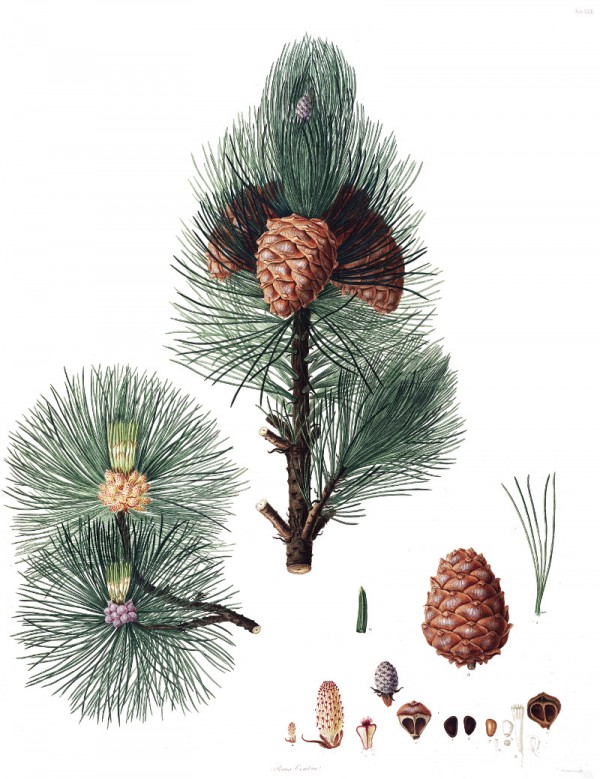
Lambert, A.B., Description of the genus Pinus and some other remarkable plants, 2nd ed., vol.1 p.34 t.23 (1890) [Ferdinand Bauer]
http://plantgenera.org/species.php?id_species=794138
Pinus cembra
© Rolf Marschner (2006),
www.botanische-spaziergaenge.at


